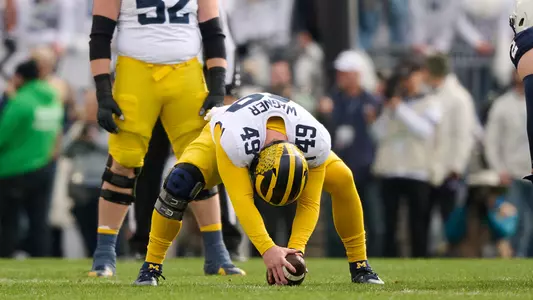Inside the Mind of a Long Snapper

The most pressure-packed 0.7 seconds in football happen in complete silence. In the roar of 80,000 fans, when the stadium lights burn brightest and the game hangs in the balance, one player operates in a bubble of absolute solitude. The long snapper—football’s most anonymous specialist—faces a psychological challenge unlike any other position in sports.
“90% of long snapping is mental,” explains William Wagner, an NFL draft prospect who has mastered the art. Like a golfer standing over a crucial putt, the long snapper must block out everything except the 15-yard space between their hands and the punter’s waiting grip.
The Mental Fortress
The psychology of long snapping begins with a fundamental paradox: these athletes are paid handsomely to be invisible. NFL long snappers can earn over $1 million annually, according to salary data, yet their greatest achievement is going unnoticed. Success means no one remembers your name. Failure means 80,000 people—and millions watching at home—know exactly who you are.
The long snapper “must embody a similar mindset to that of an offensive lineman”—a player whose specialty doesn’t appear on any stat sheet but must be executed flawlessly to create scoring opportunities. This creates a unique psychological profile: ego-less perfectionists who thrive in the shadows.
Visualization and the Art of Repetition
Former NFL long snapper Jon Dorenbos, who also happened to be a professional magician, understood the mental game better than most. Reports about his career indicate he relied heavily on mental preparation and visualization techniques in his approach to the position.
This mental preparation isn’t optional—it’s survival. In a position where the margin for error is microscopic, the mind becomes the most important muscle. Every snap must travel exactly 15 yards in precisely 0.7 seconds, with perfect spiral rotation, hitting the punter’s hands at waist level. The slightest mental lapse—a stray thought about the crowd, the score, or the consequences—can send the ball sailing over the punter’s head or skittering along the ground.
The Pressure Cooker
Long snappers face immense pressure, especially when the game is on the line, yet they must maintain an almost supernatural calm. Consider the scenario: your team is punting from its own end zone with two minutes left in a tied playoff game. The rush is coming. The crowd is deafening. One bad snap doesn’t just kill the drive—it likely ends your season.
“90% of the game is mental,” notes Wagner, emphasizing how the jump to professional football requires not just physical precision but psychological fortitude. The pressure isn’t just about the snap itself; long snappers must also contribute to punt coverage and blocking schemes, making them hybrid athletes who must seamlessly transition between mental precision and physical aggression.
The Isolation Factor
Perhaps the most psychologically challenging aspect of long snapping is the isolation it entails. While quarterbacks have offensive coordinators in their ear and linebackers get fired up by position coaches, long snappers largely operate alone. They’re often the only specialist of their kind on a roster, training in solitude and perfecting a craft that few coaches truly understand.
This isolation breeds a particular type of mental toughness—not the fiery, emotional kind that motivates linebackers, but a cool, calculated resilience. “It’s about keeping a clear head,” Wagner explains, describing the zen-like state required for consistent performance.
The Perfection Paradox
The mental burden of being a long snapper extends beyond game day. In practice, they must maintain the same precision whether it’s the first snap of spring training or the final punt of the Super Bowl. There’s no “good enough” in their world—only perfect and failure.
This creates what psychologists might recognize as a perfectionist’s nightmare: a job where anything less than flawless execution is unacceptable, performed under maximum pressure, with limited opportunities for redemption. Miss a pass as a quarterback, and you have the next play to make up for it. Miss a snap as a long snapper, and you might not get another chance for weeks.
The Art of Recovery
When mistakes happen—and they inevitably do—the mental recovery process is crucial. A bad snap in the first quarter cannot be allowed to infect the rest of the game. Long snappers must develop what sports psychologists call “next-play mentality” on steroids, instantly processing failure and moving forward without losing confidence.
The most successful long snappers describe developing mental reset rituals, including specific breathing patterns, mantras, or visualization techniques that allow them to flush mistakes immediately. They understand that dwelling on errors is professional suicide in a position with such thin margins.
The Hidden Warriors
In an era where an athlete’s mental health receives increasing attention, long snappers represent a unique case study in psychological resilience. They’ve learned to thrive in obscurity, excel under pressure, and maintain perfectionist standards while knowing that their next mistake might be their last.
At age 37, Vikings long snapper Andrew DePaola “doesn’t plan on quitting football in the near future,” exemplifying the mental durability required for the position. These athletes don’t just survive the psychological pressure—they’ve learned to find peace within it.
The next time you watch a punt, spare a thought for the long snapper. In those 0.7 seconds between snap and kick, you’re witnessing one of sports’ purest mental challenges: a single human being, alone with their thoughts, executing perfection under pressure while the world watches in silence.
In football’s grand theater, long snappers are the stagehands—invisible, essential, and operating under a psychological pressure that would crush most mortals. They’ve mastered not just the physical act of snapping a football, but the far more difficult art of controlling their minds when everything is on the line.
(Aspiring NFL Writer | Children’s Author | Chicago Bears Devotee in Chiefs Territory)
